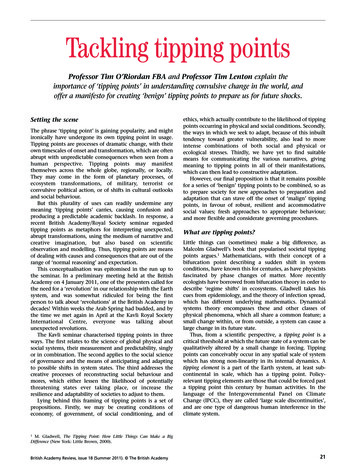
Transcription
THE YOUNG DENTIST TIPPING POINTBy Roger P. Levin, DDSSeeThe LastPage For AnExclusiveOFFERLG0615158 8 8 . 9 7 3 . 0 0 0 0 W W W. L E V I N G R O U P. C O M
THE YOUNG DENTIST TIPPING POINTBy Roger P. Levin, DDSIntroductionIn his book The Tipping Point, Malcolm Gladwell examines in part how success happens in business. Mostcompanies go through a cycle of ups and downs. If the up is big enough, then he refers to it as a Tipping Point.This is where a company goes mainstream and becomes extremely successful.In popular culture, there are many examples of Tipping Points—where a product or service goes from obscurityto ubiquity, from the fringes to the forefront. Think of Beanie Babies, cell phones, personal computers, to namejust a few items. For a product or business to reach a Tipping Point, many things have to go right. For dentalpractices, a Tipping Point is obviously not worldwide success, but a place of continual growth and successwhere debt is significantly reduced. In dentistry, it usually takes 5 – 7 years for a new practice to reach a TippingPoint. With the right management and marketing systems, dentists can get there sooner.The State of Dentistry TodayToday, the level of debt accrued by new doctors is truly staggering. It is not unusual for a new dentist to starthis or her career owing half million dollars or more. Perhaps an even more troubling concern is the inabilityof young dentists, saddled with high debt, to sufficiently invest in the practice to ensure growth in the yearsahead.Some young dentists and dental students are thinking, “Is it all worth it?” Absolutely! The challenges may appearquite daunting, but the rewards are tangible and substantial. Dentistry allows you to have a great career helpingpeople achieve better oral and overall health. This profession provides a comfortable lifestyle where you canrun your own business and make your own schedule. Dentists typically are in the top ten percentile in annualincome.How to Reach the Tipping Point SoonerDental schools teach dental students how to be dentists—not practiceowners. The business side of dentistry is what the vast majority ofdentists—both young and experienced—find the most challengingabout practicing today. Years ago, a new practice owner could hangout a shingle and he or she was virtually assured of a successful career.Today, practice success requires more planning, more effort and moreexpertise.The world of dentistry is more complex than even from a decadeago. Research and technological breakthroughs are changing theway dentistry is performed. Cosmetic and implant dentistry continueto grow. Dental insurance grows more complicated. Competition isincreasing. And then there’s the current economy, which has affectedthe way patients spend money on dental care.
THE YOUNG DENTIST TIPPING POINTWhat To Do and What Not To DoThe following tips can help new dentists succeed in today’s complex dental landscape and reach a practiceTipping Point sooner:Don’t — Overspend123456Fortunately, very few dental practices enter into bankruptcy. But it can happen. That is why Levin Groupadvises young dentists not to overspend when opening a practice. In today’s dentistry, one could easilyspend a million dollars to open a practice with advanced technologies, the latest equipment and abeautiful office design. Start with the basics, and add more when the patient base is established andthe practice begins to grow.Do — “WOW” Patients with Superior Customer ServiceAs a new dentist, you and your practice will be under the microscope. Patients will automaticallycompare your practice to their previous dental experiences. Your goal—exceed patient expectationsevery step of the way. Treat every patient like your favorite celebrity. Train your team to do the same.Make the experience an extraordinarily positive one—patients will keep coming back and they will telltheir friends and families about your practice.Don’t — Wait to Implement Documented SystemsMost new practices have excess capacity, so dentists often feel no compelling need to focus onimproving efficiency through systems. High-performance systems are critical to achieving productiongoals, reducing stress and setting the foundation for long-term success. By implementing them earlier,you can benefit from them longer.Do — Create a Vision StatementMost new dentists have a practice vision, but very few write it down. The vision is the type of practiceyou want to have in the next 3 – 5 years or even longer. By writing it down, the vision becomes real. It isno longer an idea, but something tangible. Committing the vision to paper is the first step to achievingthe vision.Don’t — Buy the Largest Yellow Pages AdYellow Pages ads are expensive and are not very effective. A better investment is a strong patientreferral program. Asking every patient for referrals can jumpstart growth. It is not embarrassing to tellpatients you are new, young and would appreciate referrals. Most patients will go out of their way tohelp a young dentist if they like the doctor and staff. Train your team to ask patients for referrals duringcheckout and post signs in high-traffic areas saying new patients are welcome.Do — Have a Professional WebsiteThe Internet is the new Main Street. Every practice needs to have a professionally designed websitewith easy-to-access information, including treatment philosophy, services, hours of operation, doctor’sbio, and email contact. Consider using Facebook, Twitter and other social media to reach current andnew patients. Remember, though, that participating on these sites while beneficial can also be verytime-consuming. A doctor’s time is usually in short supply, so proceed cautiously with social media.
THE YOUNG DENTIST TIPPING POINTDon’t — Ignore Telephone Skills78910Even in the age of the Internet, the telephone is still the practice’s main lifeline for new patients. Trainyour front desk team to make new and prospective patients welcome when they call. Have your teamwin over potential patients with powerful verbal skills and turn calls into scheduled appointmentsthrough enhanced verbal skills.Do — Hire SlowlyToo many young doctors hire more staff than they need. Starting with only a few employees whoperform multiple jobs is how most entrepreneurial businesses begin. Most entrepreneurs do not hirewho they’ll need in three years, but work a little bit harder in the early years doing more with whatthey can afford. Keep your staff small and use formulas to know when you should add the next staffmember.Don’t — Ignore the TeamYour team is a key component of your success. Provide staff members the leadership, training andmotivation they need, and your office will be well-positioned to grow dramatically in the years to come.Your team is looking to you, as the leader of the practice, for guidance. Guide your team, and they willrespond accordingly.Do — Surround Yourself with ExpertsYoung dentists, due to a lack of funding, often think they should wait to surround themselves withexperts and try to do everything on their own. The problem is that young dentists do not haveexpertise and one mistake can delay reaching the Tipping Point by years. It is important to haveexperts help with leasing, office design, management systems and staff hiring.Benefits of the Tipping PointMoving to the Tipping Point or beyond is fantastic. This means the practice will have excellent production andprofitability if all management systems are properly in place. For a young practice, it means that the dental teamcan be expanded so that each team member does not have to be a jack-of-all-trades and specialization canoccur. It means that the doctor can rely on the team for most day-to-day operations and focus consistently onpatient care which further increases production and profitability.ConclusionThere are no guarantees of fast success today. This means that young doctors have to plan ahead to sustainthe early years, implement effective marketing programs and have a realistic view of what it will take to besuccessful. A young dental practice should provide an outstanding return on investment. Follow the abovestrategies, and your new practice will soon reach a Tipping Point.
THE YOUNG DENTIST TIPPING POINTDr. Roger P. LevinDr. Roger P. Levin is a third-generation general dentist and the Chairman and CEO of LevinGroup, Inc., the largest dental practice consulting firm in North America. A keynote speakerfor major dental conferences, Dr. Levin presents more than 100 seminars per year. He hasauthored 68 books and more than 4,000 articles. In 2014, he received the Dental ExcellenceAward for Best Practice Management Consultant from DrBicuspid.com. For the past 12 years,he has been named one of the “Leaders in Dental Consulting” by Dentistry Today magazine.ADDITIONAL RESOURCES:The Platinum LibraryGet all of Dr. Roger P. Levin’s best-selling e-books in one easy-to-download purchase. Learnthe practice management and marketing essentials for growing your practice from theforemost authority on the business of dentistry. Save 10% when you purchase these booksas a set rather than separately. Go to: www.levingroup.com/store/libraries.html.The Practice Performance Analysis Get the peace of mind you deserve, with a Levin Group Practice Performance Analysis . Morethan 6,800 dentists and specialists have used this analysis to gain a better understanding oftheir practices and increase production.The analysis is conducted by a Certified Practice Analyst at your office with minimalinterruption to your business operations. During the assessment, the analyst will examineyour practice’s operations pinpoint under-performing areas and give you solutions forincreasing production. Special price is 1495, a 500 savings.To find out more, call 888.973.0000 or visit www.levingroup.com/analysis.
just a few items. For a product or business to reach a Tipping Point, many things have to go right. For dental practices, a Tipping Point is obviously not worldwide success, but a place of continual growth and success where debt is significantly reduced. In dentistry, it usually takes 5 - 7 years for a new practice to reach a Tipping Point.










